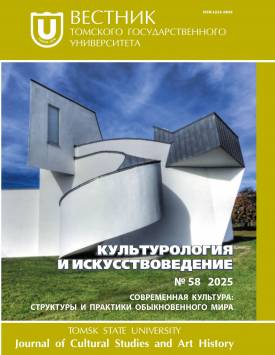Immersive technologies as a new approach to organizing museum communication and a way to attract representatives of the z and alpha generations to museums
The article examines the origins of the use of proto-immersive technologies in one form or another, with specific features of specific epochs. The evidence is provided by the research of the German art critic O. Grau, as well as the tradition of creating illusory images, now called “trompley”, and the technology of circular panoramas. The controversial position of the museum in the contented society has long been the subject of the discourse of researchers and scientists. Is a museum a temple or a forum? Is the museum a place for everyone, or is it just another way of stratifying society? One of the first people who tried to resolve this contradiction was the Russian religious thinker N.F. Fedorov. Long before the concept of immersiveness appeared, N.F. Fedorov proposed a grandiose project - the Museum of the Third estate, which was a huge complex where space and decoration played an important role in creating the atmosphere of the 19th century. The next stage in the evolutionary development of immersivity can be called the concept of a “useful museum” by the American librarian J.K. Dana. Continuing to expand the concept of the “social” proposed by N.F. Fedorov and P.A. Florensky in the structure of the museum, J.K. Dana offers a system of social museums. The American museum figure did not mean by “museum space” material values, but rather a public organization for discussion, creativity or entertainment activities. The museum, according to the researcher, should become a public platform for building a dialogue between the museum object and visitors, a mobile and socially active institution, a place of socialization of the individual. The theory of “museum communication” by Canadian scientist D. Cameron had a significant impact on understanding the principles of using immersive technologies in the museum space. D. Cameron put forward the concept of a “museum forum” capable of reorganizing the museum network into a free communication space for dialogue between various groups of the population.In the forum, visitors become co-organizers of the exhibition, which implies the possibility of experimenting with forms, museum objects, etc. Currently, the concept of immersivity in the minds of most people is primarily associated with digital technologies. The early experiences of museologists confirm that museums have been looking for opportunities for quite a long time to adjust from excessive verbal information content to a figurative perception of events, phenomena, facts, rather than individual items on display. The authors declare no conflicts of interests.
Keywords
immersive technologies, interactive technologies, digital technologies, theory of generations, museum communication, theatrical performance in the museumAuthors
| Name | Organization | |
| Putin Vladimir V. | Tomsk State University | putin_98@bk.ru |
| Polyakova Elena A. | Altai State Institute of Culture | elena2873@mail.ru |
References

Immersive technologies as a new approach to organizing museum communication and a way to attract representatives of the z and alpha generations to museums | Tomsk State University Journal of Cultural Studies and Art History. 2025. № 58. DOI: 10.17223/22220836/58/18
